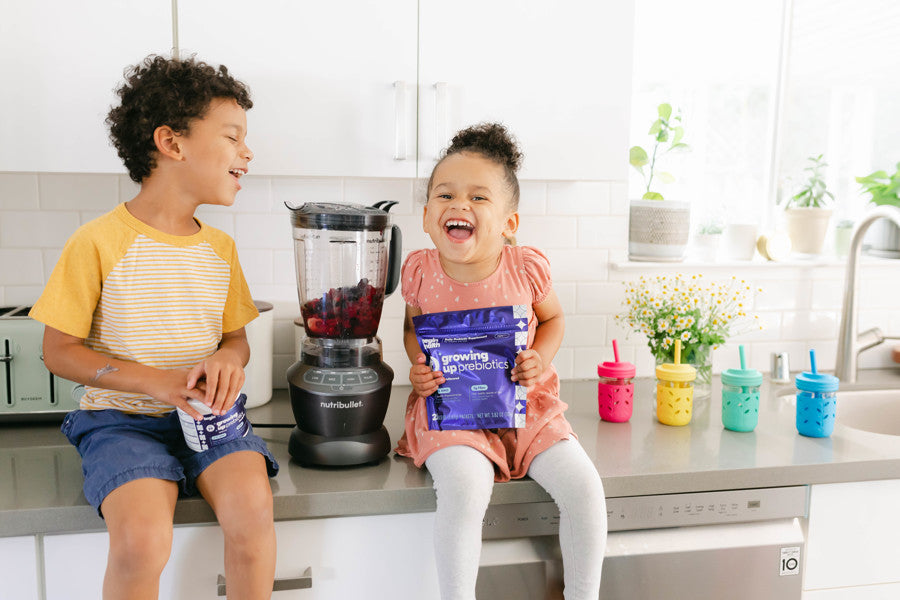Your Cart is Empty
Continue shoppingHow to Help Constipation Symptoms in Kids with Celiac’s Disease
Expert reviewed by Lauren Mahesri, RDN | Published January 24, 2025
share this article

Celiac disease is an autoimmune disorder where the immune system damages the small intestine in response to eating gluten (1).
After eating gluten, kids with celiac disease often experience diarrhea, loss of appetite, bloating, and stomach pain (1). However, even without eating gluten, they often suffer from chronic constipation.
Research shows that kids with constipation have significantly higher rates of celiac disease than kids with no constipation issues (5% vs 0.7%) (2).
Because constipation can greatly affect a kiddo’s quality of life, it’s essential to understand how to manage it to help those with celiac thrive.
Why Constipation Occurs in Kids with Celiac Disease
Both the physical nature of celiac disease and unintentional dietary trends contribute to constipation in kids with celiac.
Inflammation Causes Slow Digestion
When kids with celiac disease eat gluten, their immune system identifies gluten as a threat. While attempting to eliminate gluten, the gut lining becomes damaged in the process.
Over time, this damage to the gut lining can slow down how fast stool moves through the digestive tract, ultimately leading to constipation.
According to the Celiac Disease Foundation, more than ⅓ of people with celiac disease struggle with this altered gut motility.
Gut Absorption Issues
Damage to the gut lining can also cause the intestine to absorb too much water during digestion (4). This makes stool harder and more difficult to pass, leading to constipation.
Accidental Low-Fiber Diet
The treatment for celiac disease includes a strict gluten-free diet. Because of this, many kids unintentionally don’t reach their fiber goals as gluten is in many traditionally fibrous foods like bread, pasta, cereals, and crackers.
Even without gluten-free restrictions, an estimated 95% of kids do not eat enough daily fiber (3). Eliminating more foods from kid’s options makes it even more difficult and often results in constipation.
Begin Health's Expert Tip
Check out which foods can contribute to constipation in this blog here.
Simple Changes to Reduce Constipation with Celiac’s Disease
Increase Gluten-Free Sources of Fiber
Gluten-free diets are often much lower in fiber due to the types of foods restricted. To combat this and reduce overall constipation, offer 1-2 gluten-free sources of fiber to your kiddos at each meal.
Gluten-Free High-Fiber Foods
-
Pears
-
Raspberries
-
Chia Seeds
-
Flax Seeds
-
Beans
-
Lentils
-
Avocado
-
Brown Rice
-
Quinoa
-
Nuts
-
Sweet Potatoes
Prebiotics to Improve the Gut Lining
Because constipation can result from damage to the gut lining, addressing this issue is key for your little one to have normal bowel movements.
That’s where prebiotics come in! Prebiotics act as food for beneficial gut bacteria, which then produce Short Chain Fatty Acids (SCFAs). These SCFAs nourish and strengthen the gut lining to help speed up digestion (5).
The chicory root inulin and Human Milk Oligosaccharides (HMOs) inGrowing Up Prebiotics are powerful prebiotics that help nourish and strengthen the gut lining.
Plus, Growing Up Prebiotics is tasteless and textureless, providing 3 grams of fiber per serving. A win-win for kids with celiac disease to reduce symptoms of constipation such as irregularity and painful poops!
Hydration
Proper hydration helps to soften stool and make it easier to pass through the digestive tract. Drinking enough water is especially important when your kiddo starts to eat more fiber (as recommended above) to help further soften stool.
According to theAmerican Academy of Pediatrics, kids ages 1-3 should drink 4 cups per day, 5 cups for 4-8-year-olds, and 7-8 cups for kids 9 and up.
Movement
Regular movement and exercise stimulate the muscles in the digestive tract which helps move stool through more easily (6). If you've already tried to optimize your kid’s diet with fiber, prebiotics, and water, it might be their movement patterns that are contributing to constipation!
Start by encouraging your kiddo to do short 20-minute bouts of movement after meals, as it helps initiate digestion and can significantly lessen symptoms of constipation.
Summary
Kids with celiac disease are at higher risk for constipation, which can be caused by gut inflammation, a low-fiber diet, and absorption issues.
To manage constipation symptoms, it’s important to increase gluten-free sources of fiber, use prebiotics to support gut health, properly hydrate, and increase daily movement.

Author
Lauren Mahesri, RDN
Trending

How to Transition Kids Off Stool Softeners Safely
read now
How to Know If Your Kid Needs a Stool Softener (or Something Else)
read now
Why Parents Are Choosing Prebiotics Over Stool Softeners for Kids
read now






